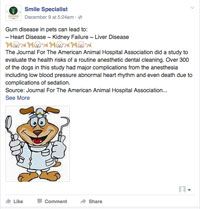Southern California a hotspot for anesthesia-free dental controversy
A recently publicized client horror story keeps care, revenue and oversight regarding the procedure in the spotlight.
Recently a local news station in Southern California, NBC4, reported that a cat named Monkey-face died after a visit to Smile Specialist, an anesthesia-free pet dental service.
A week after Monkey-face's $100 cleaning, which was supervised by a veterinarian, the cat wouldn't eat or drink, according to the report. Monkey-face's owner took the cat to her regular veterinarian, who found that the patient's tongue was almost completely severed and infected. The cat was euthanized
The story has revived the controversy over anesthesia-free dental cleanings for pets. “This is a discussion that's been going on in the state of California at least 20 to 25 years,” says Peter Weinstein, DVM, MBA, executive director of the Southern California Veterinary Medical Association.
Weinstein says anesthesia-free dental care lives in a hazy gray area of the practice act. His take? Veterinarians should keep hold of the service rather than shunning it to the point that it's beyond veterinary oversight.
Like it or not, there's a market for it
Weinstein says what started as an influx of uncertified grooming, pet stores and boarding facilities that aggressively marketed anesthesia-free dental cleanings has grown into four highly competitive business models in Southern California:
• Anesthesia-free dental cleanings done by uncertified groomers, boarding facilities and pet stores
• Nonveterinary businesses providing anesthesia-free dental cleanings with direct supervision by veterinarians
• Anesthesia-free dental cleanings done by certified technicians at veterinary hospitals with direct veterinary supervision
• Veterinarians and veterinary technicians with mobile premise permits setting up outside boarding and grooming facilities to do anesthesia-free dental cleanings.
Weinstein believes the procedure should always be done with veterinary oversight, as stipulated by the practice act. But it's difficult for the California Veterinary Medical Board to crack down on unlicensed activity, he says. At most it can impose a fine-and then only if a consumer makes a complaint of significant damage.
Educate the uneducated
Weinstein believes the pet owners who pursue anesthesia-free dental care at nonveterinary facilities fail to understand the risks. “They're making the pet look pretty for all intents and purposes, but there's still disease going on,” Weinstein says. “From a clinician's standpoint, that's totally inappropriate.”
Furthermore, Weinstein says, these consumers have two fears: money (spending it) and anesthesia (death from it). “Both fears can be ameliorated with education,” he says.

But the Internet isn't helping, Weinstein says. Uncertain pet owners will find their fears confirmed in anesthesia-free marketing. For example, a recent post on the Smile Specialist Facebook page reads, “The Journal for the American Animal Hospital Association did a study to evaluate the health risks of a routine anesthetic dental cleaning. Over 300 of the dogs in this study had major complications from the anesthesia including low blood pressure, abnormal heart rhythm and even death due to complications of sedation.”
The post fails to mention that AAHA guidelines state that general anesthesia with intubation is necessary to properly assess and treat companion animal dental patients and, without it, patients are subject to increased stress and risk.
Keep your enemies close
However, Weinstein believes there's room for veterinary hospitals to offer high-quality, veterinarian-supervised anesthesia-free dental cleaning as a dental maintenance service.
“There are probably patients with minimal tartar, no disease, who have had a full cleaning who warrant an anesthesia-free cleaning at a hospital,” he says. “I think it's a maintenance-type situation or starting some young dogs with hand scaling to get used to it. It's not appropriate for every dog or cat, or appropriate for every technician, doctor, hospital or client.”
He says it's all about case selection and a judicious approach to the issue. “I've watched the procedure being done,” he says. “We had one of the anesthesia-free technicians come in with a dog and sit on the floor and clean the dog's teeth. It was very impressive.”
He adds that the patients was a black Lab-he'd like to see her try it with a Chihuahua.
Weinstein also watched the technician clean a cat's teeth while it was wrapped in a towel. “It can be done in what appears to be a low-stress fashion,” Weinstein says.
But he says the appropriate judicious approach is unlikely to happen without veterinary oversight. “The veterinarian gets to see [the animal] six months later and see all these loose white teeth,” Weinstein says. The pet owner only knows that “the groomer takes care of it,” he says. “They've never been told about the pathology.”